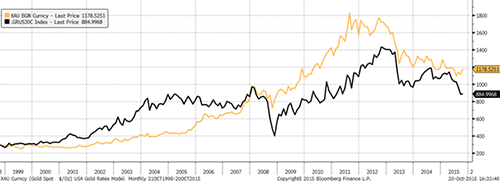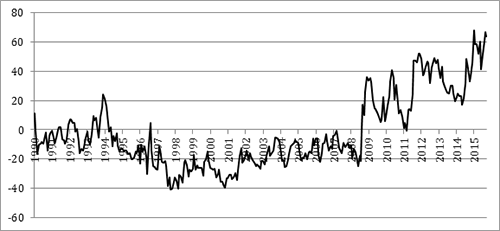Hello – and first of all let me say what a pleasure it is to write to you here at Capital and Conflict. I hope I have the chance to share more of my ideas with you in the coming weeks.
But let’s get straight down to it and talk about gold. I was recently invited to talk at the LBMA annual conference in Vienna.
It was my first trip to Vienna and, I have to say, it’s a stunning city. There was beautiful scenery, nice people who spoke excellent English with pubs (that you can smoke in) that are open until 6am. A good conference can be fun. You catch up with friends, get to meet new people and get closer to your industry at the same time. This conference was well executed and highly professional in every sense, and there’s no crime in singing Edelweiss in a hotel bar.
Most people might assume that the LBMA delegates are a bunch of doomsters and nutters, but they couldn’t be more wrong. The gold industry is run by good folk, and few, if any, could be described as gold bugs. They are just hard working people that keep the cogs of the gold industry in motion.
Valuing gold
I sat on a panel on ‘precious metals as an investment’. It was chaired by John Authers from the FT. He presented on how ‘overvalued’ the stock market was and the outlook for the dollar. Also on the panel were Diego Parilla, author of ‘The energy world is flat’, Mike Sheehan, a hedge fund manager at Orion Capital, and the former LBMA Chairman, Jon Spall.
I told the audience about gold’s fair value and further discussed the current premium in the price. I also mentioned the potential for gold to trade using blockchain technology; a synopsis of an article that I wrote for the LBMA’s Alchemist magazine.
I felt fair value was an important topic because commodities have collapsed in 2015, yet gold is flat on the year in dollar terms. I used three valuation techniques that all see gold in the $800 area. Part of me expected to get pelted with such low numbers, but few seemed to disagree. Here is what I discussed.
Gold as a bond
If gold is a bond, what kind of bond is it? To answer that question, we have to consider its merits. Firstly, it pays no interest so is ‘zero coupon’. Secondly, it must be ‘inflation-linked’ because it is a long-term store of value. Thirdly, it has no ‘credit’ risk and finally, gold has been issued by ‘god’.
That can be put into an equation:
Fair value = 3.3 x CPI x (inflation expectations)^30 / (real rates)^30
Where real rates are inflation expectations less the long bond yield. I opted for 30 year bonds and 30 year inflation expectations because that reflects the idea of a ‘long-term store of value’. The final task is to calibrate the model. The average of gold versus the model since 1998 has been 3.3. I accept that may be too low, but we won’t fully know until more data becomes available in the future.
Gold Rates Model
Chart note: The chart shows the gold price (gold) against my rates model (black). The correlation between them is high. The behaviour in 2008 and the rally thereafter can be explained by changes in rates. This was particularly pertinent during the ‘taper tantrum’ in April 2013.
Gold is currently 33% above fair value on this basis. Interestingly, gold was too cheap in 2004. It traded at $400 but should have been $800. It took three years to catch up but it got there in the end. Most recently, the rates model has fallen back implying a fair value of $884. This is primarily due to falling inflation expectations whilst bond yields are holding steady. That is described as ‘rising real rates’.
Gold as a Commodity
If it quacks like a duck, it’s a duck. In my opinion, gold is simply a commodity that has superior ‘quality’ to the rest of the market. This model looks at 20 year relationships between gold and other commodities.
For example the gold to silver ratio has averaged 61.3 over the past two decades. The gold to copper ratio has averaged 3.6 (ounces to pounds) and the gold to oil ratio has average 13.92 (ounces to barrels). I also have done this for platinum, palladium, gas, wheat, soybeans, coffee, corn and sugar.
Commodity prices tend to be mean reverting, meaning there is no net winner over time. If something rises faster than the market, one day it will give it all back, either by falling, or by the rest of the market catching up. Of course some commodities lose their relevance such as whale oil, so I use medians rather than means to accommodate for this.
On this basis gold is 62% above its commodity fair value. That’s pretty much an all time high.
Gold relative to commodities
Chart note: The chart shows the price of gold relative to commodities. I have looked at the average price of gold relative to silver, platinum, palladium, oil, gas, wheat, soybeans, coffee, corn, sugar and copper over a 20-year period.
In order to dismiss outliers, I have taken the median value over time. Gold is currently at a 62% premium to commodities. The gold price has been flat this year whilst commodities have fallen. This premium has been evident since the credit crisis. Gold was significantly undervalued, on this same basis, at the turn of the millennium.
The ‘Golden Constant’ fair value
If gold is a long-term store of value, it ought to buy the same number of houses, hours of labour or loaves of bread over the long-term. This model is deliberately slow so I don’t think the number should be taken too seriously; in terms of accuracy. This is, however, a simple attempt to measure the ‘peoples’ inflation. It’s just a guide but shows gold to be 19% above fair value.
The Golden Constant Fair Value
Chart note: The price of gold is compared to a long-term attempt to measure inflation using energy, labour, food and housing. The premium would matter less if the black line was rising. Unfortunately, deflationary forces are showing up and the fair value is falling, thus widening gold’s premium.
Putting it all together
My favourite gold guru was at the conference (sadly I can’t name him) and he broadly agreed with my work. Furthermore, he made some good points. Over the years, mine supply has generally matched demand from areas such as jewellery and coin. In a natural state, the market is balanced and investor demand has been the swing factor. He said that if investors remain committed to gold, the current premium to fair value, of let’s say $300, will remain. If they leave, the premium will erode.
A fair value of $800 isn’t quite the same thing as predicting that gold will fall to $800. More importantly, we must try to understand why there’s a premium in the first place. Given it has come into being post the 2008 crisis, the logical conclusion is that investors are paying a premium for insurance; they want protection from the possibility that the financial system comes under pressure.
In that sense, $300 per ounce isn’t that much extra to pay for insurance. If the world doesn’t fall apart, you might see your gold slip down to $800, but if it does, you’ll be one of the few people with tangible assets.
Whatever happens, this premium will disappear at some point in time and that can happen in two ways. Firstly, the world economy could improve. If so, the USA hikes, China doesn’t crash and cheap energy gives the world a boost. That means commodities stay low and gold ‘falls down’ to them.
The alternative scenario is that the economy slows and QE 4,5,6 or nominal GDP targeting becomes prevalent and leads to higher inflation. Under these scenarios, commodities might catch up with gold, but rise at a lesser pace.
Category: Market updates




